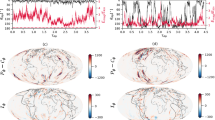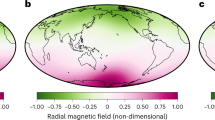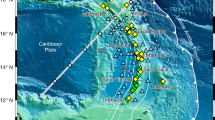Abstract
Dynamical effects at the core–mantle boundary have so far been modelled mainly with thermal convection1,2, yet accumulating evidence3,4 supports the idea of a combined thermal and chemical boundary layer as the likely explanation of the D″ zone. Here we present numerical simulations of thermal-chemical instabilities in the D″ layer which show that strong lateral heterogeneities in the composition and density fields can be initiated and maintained dynamically if there is continuous replenishment of material from subduced slabs coming from the upper mantle. These chemical instabilities have a tendency to migrate laterally and may help to support core–mantle boundary topography with short and long wavelengths. The thermal-chemical flows produce a relatively stagnant D″ layer with strong lateral and temporal variations in basal heat flux, which gives rise to thermal core–mantle interactions5, influencing the geodynamo.
This is a preview of subscription content, access via your institution
Access options
Subscribe to this journal
Receive 51 print issues and online access
$199.00 per year
only $3.90 per issue
Buy this article
- Purchase on SpringerLink
- Instant access to full article PDF
Prices may be subject to local taxes which are calculated during checkout
Similar content being viewed by others
References
Hager, B. H., Clayton, R. W., Richards, M. A., Comer, R. P. & Dziewonski, A. M. Nature 313, 541–545 (1985).
Zhang, S. & Yuen, D. A. Geophys. Res. Lett. 14, 899–902 (1987).
Young, C. J. & Lay, T. A. Rev. Earth, planet. Sci. 15, 25–46 (1987).
Creager, K. C. & Jordan, T. H. Geophys. Res. Lett. 13, 1497–1500 (1986).
Bloxham, J. & Gubbins, D. Nature 325, 511–513 (1987).
Morclli, A. & Dziewonski, A. M. Nature 325, 678–683 (1987).
Olson, P., Schubert, G. & Anderson, C. Nature 327, 409–413 (1987).
Davies, G. F. & Gurnis, M. Geophys. Res. Lett. 13, 1517–1520 (1986).
Anderson, D. L. Phys. Earth planet. Inter. 45, 307–323 (1987).
Brown, J. M. Geophys. Res. Lett. 13, 1509–1512 (1986).
Zhang, S. & Yuen, D. A. Geophys. Res. Lett. 15, 451–454 (1988).
Hofmann, A. W. & White, W. M. Earth planet. Sci. Lett. 57, 421–436 (1982).
Christensen, U. R. EOS 68, 1488 (1987).
Hansen, U. & Yuen, D. A. Geophys. Res. Lett. 14, 1099–1102 (1987).
Hansen, U. & Ebel, A. Geophys. J. 194, 181–191 (1988).
Williams, Q., Jeanloz, R., Bass, J., Svendsen, B. & Ahrens, T. J. Science 236, 181–182 (1987).
McKenzie, D. P. J. Petrology 25, 713–765 (1984).
Author information
Authors and Affiliations
Rights and permissions
About this article
Cite this article
Hansen, U., Yuen, D. Numerical simulations of thermal-chemical instabilities at the core–mantle boundary. Nature 334, 237–240 (1988). https://doi.org/10.1038/334237a0
Received:
Accepted:
Issue date:
DOI: https://doi.org/10.1038/334237a0
This article is cited by
-
Plate Tectonics: The Stabilizer of Earth’s Habitability
Journal of Earth Science (2023)
-
The large-scale structure of convection in the Earth's mantle
Nature (1990)



